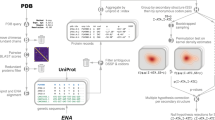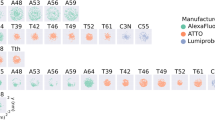Abstract
Many different factors contribute to secondary structure propensities, including φ,ψ preferences, side-chain interactions, steric effects and hydrophobic tertiary contacts. To deconvolute these competing factors, we have adopted a novel approach which quantifies the intrinsic φ,ψ propensities for residues in coil regions (that is, residues not in α-helix and not in β-strand). Comparisons of intrinsic φ,ψ propensities with their equivalent secondary structure propensities show that while correlations for helix are relatively weak, those for strand are much stronger. This paper describes our new φ,ψ propensities and provides an explanation for the variations observed.
This is a preview of subscription content, access via your institution
Access options
Subscribe to this journal
Receive 12 print issues and online access
$189.00 per year
only $15.75 per issue
Buy this article
- Purchase on Springer Link
- Instant access to full article PDF
Prices may be subject to local taxes which are calculated during checkout
Similar content being viewed by others
References
Chou, P.Y. & Fasman, G.D. Predictions of the secondary structure of proteins from their amino acid sequence. Adv. Enzmol. 47, 45–148 (1978).
Wójcik, J., Altmann, K.-H. & Scheraga, H.A. Helix-coil stability constants for the naturally occurring amino acids in water. XXIV. Biopolymers 30, 121–134 (1990).
Smith, C.K., Withka, J.M. & Regan, L. A thermodynamic scale for the β-sheet forming tendencies of the amino acids. Biochemistry 33, 5510–5517 (1994).
Minor, D.L. & Kim, P.S. Measurement of the β-sheet forming propensities of amino acids Nature 367, 660–663 (1994).
Minor, D.L. & Kim, P. Context is a major determinant of β-sheet propensity. Nature 371, 264–267 (1994).
Horovitz, A., Matthews, J.M. & Ferscht, A.R. α-helix stability in proteins. II. Factors that influence stability at an internal position. J. molec. Biol. 227, 560–568 (1992).
Blaber, M., Zhang, X.-J. & Matthews, B.W. Structural basis of amino acid α-helix propensity. Science 260, 1637–1640 (1993).
Padmanabham, S., Marquesse, S., Ridgeway, T., Laue, T.M. & Baldwin, R.L. Relative helix forming tendencies of the amino acids. Nature 344, 268–270 (1990).
Lyu, P.C., Liff, M.I., Marky, L.A. & Kallenbach, N.R. Side chain contributions to the stability of α-helical structure in peptides. Science 250, 669–671 (1990).
O'Neil, K.T. & DeGrado, W.F. A thermodynamic scale for the helix forming tendencies of the commonly occurring amino acids. Science 250, 646–651 (1990).
Kim, C.A. & Berg, J.M. Thermodynamic β-sheet propensities measured using a zinc finger host peptide. Nature 362, 267–270 (1993).
Hermans, J., Anderson, A.G. & Yun, R.H. Differential helix propensities of small apolar side chains studied by molecular dynamics simulations. Biochemistry 31, 5646–5653 (1992).
Gibrat, J.-F., Robson, B. & Gamier, J. Influence of local amino acid sequence upon the zones of the tosional angles φ and ψ adopted by residues in proteins. Biochemistry 30, 1578–1586 (1991).
Kang, H.S., Kurochina, N.A. & Lee, B. Estimation and use of protein backbone angle probabilities. J. molec. Biol. 229, 448–460 (1993).
McGregor, M.J., Islam, S.A. & Sternberg, M.J.E. Analysis of the relationsihp between side-chain conformation and secondary structure in globular proteins. J. molec. Biol. 198, 295–310 (1987).
Ralston, E. & DeCoen, J.-L. Folding of polypeptide chains induced by the amino acid side-chains. J. molec. Biol. 83, 393–420 (1974).
Garratt, R.C., Taylor, W.R. & Thornton, J.M. The influence of tertiary structure on secondary structure prediction. FEBS letts 188, 59–62 (1985).
Garratt, R.C., Taylor, W.R. & Thornton, J.M. An extension of secondary structure prediction towards the prediction of tertiary structure. FEBS letts 280, 141–146 & 401 (1991).
Zhou, N.E., Monera, O.D., Kay, C.M. & Hodges, R.S. α-helical propensities of amino acids in the hydrophobic face of an amphipathic α-helix Protein and Peptide letts. 1, 114–119 (1994).
Muñoz, V. & Serrano, L. Elucidating the folding problem of helical peptides using empirical parameters. Nature struct. Biol. 1, 399–409 (1994).
Zimmerman, S.S., Pottle, M.S., Némethy, G. & Scheraga, H.A. Conformational analysis of the 20 naturally occurring amino acid residues using ECEPP Macromolecules 10, 1–9 (1977)
Finkelstein, A.V. & Ptitsyn, O.B. Theory of protein molecule organisation. I. Thermodynamic parameters of local secondary structures in the unfolded protein chain. Biopolymers 16, 469–495 (1976).
Finkelstein, A.V. & Ptitsyn, O.B. A theory of protein molecule self organisation.IV. Helical and irregular local structures of unfolded protein chains. J. molec. Biol. 103, 15–24 (1976).
Muñoz, V. & Serrano, L. Intrinsic secondary structure propensities of the amino acids, using statistical φ–ψ matrices: Comparison with experimental studies Proteins 20, 301–311 (1994).
Bernstein, F.C., et al. The Protein Data Bank: A computer based archival file for macromolecular structures. J. molec. Biol. 122, 535–542 (1977).
Kabsch, W. & Sander, C. Dictionary of protein secondary structure. Biopolymers 22, 2577–2637 (1983).
Janin, J., Wodak, S., Levitt, M. & Maigret, B. Conformation of amino acid side-chains in proteins. J. molec. Biol. 125, 357–386 (1978).
Ponder, J.W. & Richards, F.M. Tertiary templates for proteins. J. molec. Biol 193, 775–791 (1987).
Dunbrack, R. & Karplus, M. Conformational analysis of the backbone dependent rotamer preferences of protein side-chains. Nature struct. Biology 1, 334–339 (1994).
Pickett, S.D. & Sternberg, M.J.E. Empirical scale of side chain conformational entropy in protein folding. J. molec. Biol. 231, 825–839 (1993).
Creamer, T.P. & Rose, G.D. Side-chain entropy opposes α-helix formation but rationalises experimentally determined helix forming propensities Biochemistry 89, 5937–5941 (1992).
Bai, Y., Milne, J.S., Mayne, L. & Englander, S.W. Primary structure effects on peptide group hydrogen exchange. Proteins 17, 75–86 (1993).
Bai, Y. & Englander, S.W. Hydrogen bond strength and β-sheet propensities: the role of a side chain blocking effect. Proteins 18, 262–266 (1994).
Efimov, A.V. Standard conformations of polypeptide chains in irregular regions of proteins. Molecular Biology (Moscow) 20, 208–216 (1980).
Wilmot, C.M. & Thornton, J.M. β-turns and their distortions: a proposed new nomenclature. Prot. Engng. 3, 479–493 (1990).
Kraulis, P.J. MOLSCRIPT: A program to produce both detailed and schematic plots of protein structures J. App. Cryst. 24, 946–950 (1991).
Author information
Authors and Affiliations
Rights and permissions
About this article
Cite this article
Swindells, M., MacArthur, M. & Thornton, J. Intrinsic φ,ψ propensities of amino acids, derived from the coil regions of known structures. Nat Struct Mol Biol 2, 596–603 (1995). https://doi.org/10.1038/nsb0795-596
Received:
Accepted:
Issue Date:
DOI: https://doi.org/10.1038/nsb0795-596
This article is cited by
-
Dihedral angle preferences of amino acid residues forming various non-local interactions in proteins
Journal of Biological Physics (2017)
-
Structure Motivator: A tool for exploring small three-dimensional elements in proteins
BMC Structural Biology (2012)
-
VITAL NMR: using chemical shift derived secondary structure information for a limited set of amino acids to assess homology model accuracy
Journal of Biomolecular NMR (2012)
-
Conformational distributions of denatured and unstructured proteins are similar to those of 20 × 20 blocked dipeptides
Journal of Biomolecular NMR (2012)
-
Maximum entropy reconstruction of joint φ, ψ-distribution with a coil-library prior: the backbone conformation of the peptide hormone motilin in aqueous solution from φ and ψ-dependent J-couplings
Journal of Biomolecular NMR (2007)



